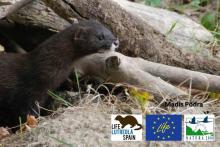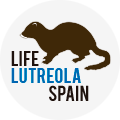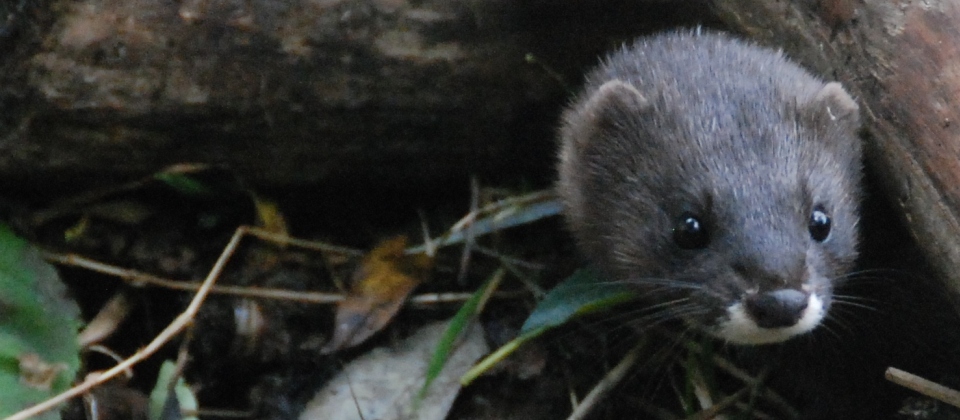You are here
FINAL Seminar LIFE LUTREOLA SPAIN: Results obtained and future actions

The fifth and last technical seminar LIFE LUTREOLA SPAIN took place on November 6th, in which we have presented the results obtained in the project and the future prospects of the conservation of the species.
The LIFE LUTREOLA SPAIN project comes to an end after more than four years of work for the recovery of the European mink in our country. In our last seminar, in addition to sharing the experiences acquired during this time, we considered the actions that are necessary for the preservation of the species in the future.
We were accompanied by specialist technicians who have collaborated in the protection of the most threatened mammal in Europe.
Speakers and Program:
- Antonio Galera. Diputación Foral de Bizkaia. Montes engineer, head of the Natural Heritage Service of the Diputación Foral de Bizkaia, responsible for the management of protected natural areas and the Natura 2000 network, of Species of fauna (non-hunting) and wild flora, and of invasive alien species. Since the year 1998 has developed an extensive work related to the conservation and management of threatened fauna and flora in Bizkaia.
- Asunción Gómez. Tragsatec. Dedicated for more than fifteen years to the conservation of the European mink in Spain, has collaborated in many works of the species and the eradication of the American Mink. She is the coordinator of the in situ conservation actions of the LIFE LUTREOLA SPAIN project.
- Madis Põdra. Asociación visón europeo. He dedicated the first years of his professional life to the reintroduction of the European mink on the island Hiiumaa in Estonia. In recent years he has coordinated the ex situ program of the species in Spain. In addition to actively participating in the monitoring of the European mink and the control of the American mink, he is the coordinator of the ex situ conservation actions of the LIFE LUTREOLA SPAIN project.
- Iñigo Zuberogoitia. Icarus Estudios Medioambientales. He develops his professional activity as an environmental consultant and freelance researcher. In the latter case, it focuses its activity on the field of applied ecology and behavior of mesocarnivores and birds . His publications include scientific articles on the evolution of the populations and ecology of the European mink and the American in Bizkaia.
- Andrzej Zalewski. Mammal Research Institute Polish Academy of Sciences Bialowieza. Polonia. Its main fields of research include ecology and conservation of carnivores, especially mustelids. He is the author of 20 scientific articles and a specific book on European martens. His current research projects focus on: Strategies for the use and reproduction of space in solitary carnivores (mainly medium-sized mustelids); and influence of the American Mink introduced on the autochthonous fauna and its competition with native predators.
- Tiit Maran. Foundation Lutreola. Estonia. Zoologist and Estonian ecologist, is member of the Committee of Breeding of the European mink in Spain and coordinator of the EEP of the species (European program of Breeding of endangered species), is considered one of the greatest experts in the conservation and captive breeding of the European mink.
9:00 Reception
9:50 Welcome
10:00 The European mink in Bizkaia. Antonio Galera. Head of service of Medio Natural. Diputación Foral de Bizkaia.
10:30 Four years of the LIFE LUTREOLA SPAIN project. Asunción Gómez. Coordinator of the in situ conservation actions of LIFE LUTREOLA SPAIN. Tragsatec. Click here to watch the video of the presentation.
11:20 Coffee break
11:50 Future actions for the conservation of the species. Madis Põdra. Coordinator of the ex situ conservation actions of the LIFE LUTREOLA SPAIN project. European Mink Association.Click here to watch the video of the presentation.
12:40 Control of American Mink in Bizkaia. Iñigo Zuberogoitia. Icarus Environmental Studies. Click here to watch the video of the presentation.
13:30 Lunch
14:30 Conservation of Mustelids in Poland and American mink. . Andrzej Zalewski. Mammal Research Institute Polish Academy of Sciences Bialowieza. Polonia
15:30 Prospects for ex situ conservation of European mink in Europe. Tiit Maran. Foundation Lutreola. Estonia. Click here to watch the video of the presentation.
16:30 Debate and conclusions
You can see the video of the final debate in our Media Gallery.
Moderator: Iñaki Benito Iza. Head of biodiversity and landscape section of the Diputación Foral de Bizkaia.
Conclusions to the "Final Seminar LIFE LUTREOLA SPAIN: Results obtained and future actions"
- For the conservation of the European mink in situ, it is necessary to eliminate the impact of the American mink:
- Establish a monitoring network within the European mink distribution area in the free rivers of the invasive species to prevent its (re)colonization.
- Eradicate the American vision within the European mink distribution area where it is still present.
- In the areas close to the European mink distribution area, the control of the American mink must be considered.
- To evaluate the impact of the eradication and control work, it would be advisable to support them in scientific studies.
- The American mink also has a strong negative impact on other species in aquatic ecosystems.
- The EC must include the American mink in the list of invasive alien species of community interest.
- It is necessary to have accurate and sufficient information about the state of the European mink in situ:
- For an effective evaluation, it must act jointly and in a coordinated manner throughout its distribution area.
- Include the European mink in Annex II of the Convention on the Conservation of Migratory Species of Wild Animals (CMS), requiring international agreements for its conservation and management.
- Maintain the captive population of European mink:
- Provide more resources to the Breeding Program and manage it globally in Europe.
- Need for a high capacity center to improve breeding results.
- Improve the state of conservation through releases as a tool to support the previous actions.
You can download the presentations of the speakers at the end of this page.



